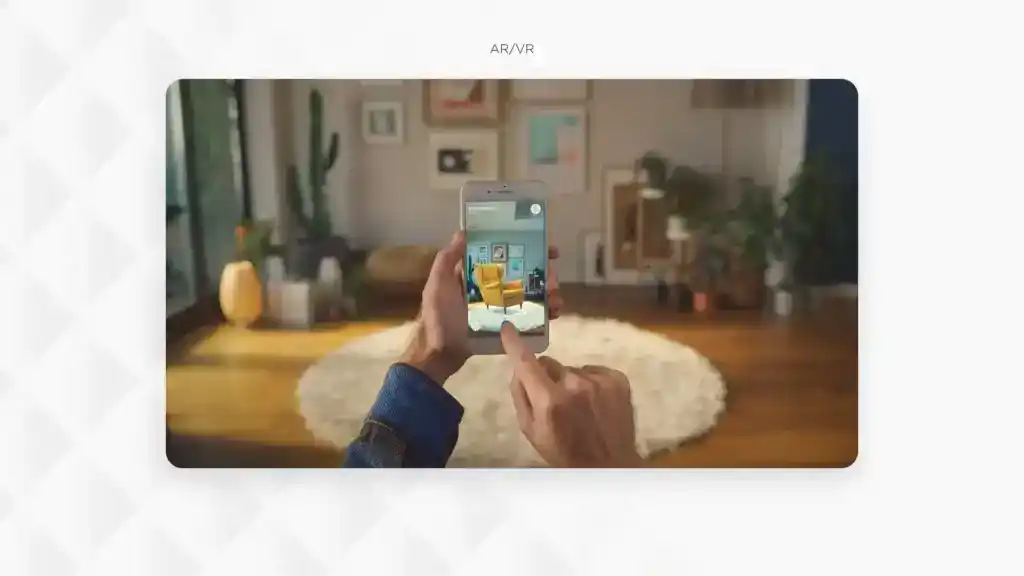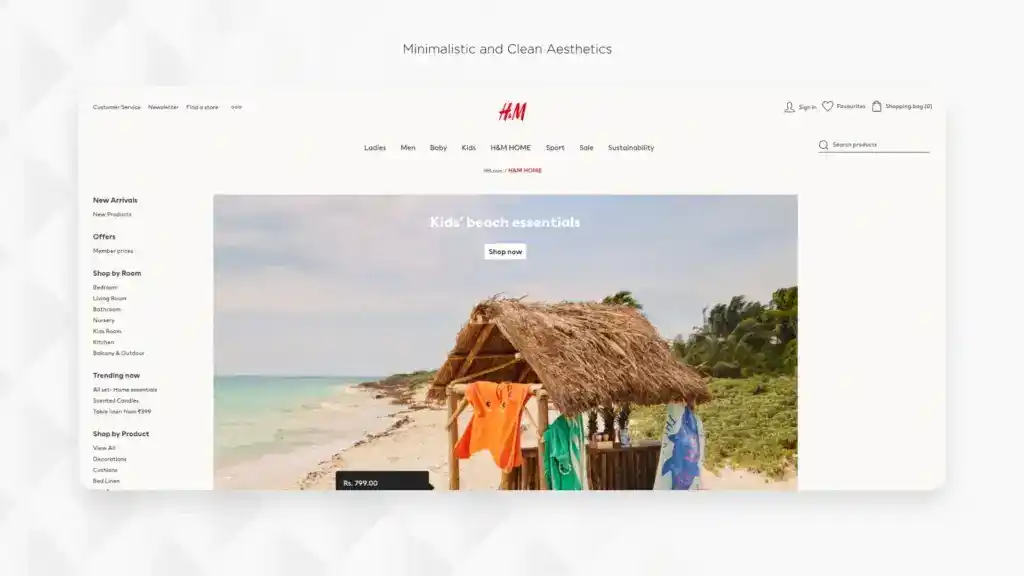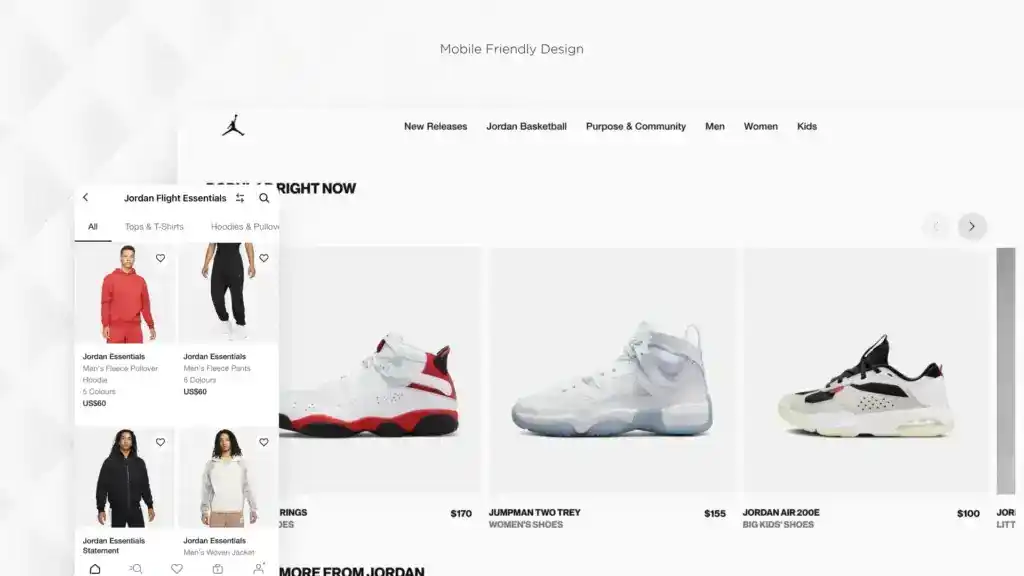Bored of dull and monotonous e-commerce designs? In 2024, where new designs are emerging daily, it is crucial to be up-to-date with e-commerce design trends to enhance the user experience. Ditch boring designs and start creating interesting and interactive designs to win customers. In this digital age, flashy designs will not excite customers anymore; the designs have to be intuitive and responsive. Moreover, it should contribute to the overall aesthetics of the e-commerce website.
Are you aware that 73% of users click away from websites that are not mobile-friendly? Crafting an e-commerce platform that captivates and converts is imperative. E-commerce design should be inclusive, personalized, and aesthetic to engage customers.
Let’s learn how to convert visitors into customers with 15 e-commerce website design trends for 2024.
Article content
Top 15 E-Commerce Design Trends 2024
Here are 15 e-commerce design trends to add to your inventory! Learn these designs and create mind-blowing e-commerce designs.
360-Degree Product Views

E-commerce focuses on enticing customers to purchase products. One major drawback of e-commerce is its inability to allow customers to touch or feel the products. Providing a 360-degree product view partially solves this problem. The 360-degree product view lets customers have a better look at the product, just like they can if they are purchasing it in a supermarket. The customer will be able to rotate and zoom in on the product to get a better look.
Studies show that customers are more likely to buy a product whenever they have a better look at it. That is to say, this design will be helpful for people who read the ingredients of a product before buying it. Letting customers have a 360-degree look at the product builds trust and reduces the return rate.
Voice Search

No more fumbling with the keyboard anymore. Voice search lets customers access the application and search for products through voice commands. The Voice interface design is an inclusive design that lets everyone access the application regardless of disabilities and makes it easy for them. Imagine getting a list of products just by a voice command: “Find me a white sneaker.”
Moreover, it caters to a busy lifestyle. Searching for a product while cooking or watching TV saves the time required to search for it manually and increases the chance of buying it. Voice searches are one of the components of AI. Significantly, retailers use the design on their e-commerce websites to increase the user experience.
AR and VR

Customers face a major online shopping problem: the “try on” feature. Many customers abandon the website if they are unsure whether the product suits them. Be it an appliance or a dress, AR and VR let customers try out the products in real-time with the help of VR and AR gear. A recent study shows that 46% of users use the voice search option.
AR and VR provide an immersive experience and eliminate the drawback of being unable to try them out. For example, if you are looking for a TV but are unsure whether it would fit perfectly in your space, you can turn on your camera and face it toward the space where you want to fix it. The e-commerce application would show a realistic TV model for you to see whether it would fit in the space. Moreover, there are virtual, realistic shops where you can walk through and look for products in real-time with the help of VR and AR gear.
Micro Interactions

In the digital age, where people’s attention spans are getting shorter daily, e-commerce websites must add micro-interactions to their designs to keep customers hooked. Micro-interactions are small and exciting animations that interact with customers when they hover the cursor on them. They provide a visually pleasing experience. The primary purpose of micro-interactions is to navigate customers.
For example, imagine a button that changes color when clicked or a cart that bounces when a product is added to the cart. Research shows that micro-interactions increase the conversion rate by 20%. Focusing on such small details contributes to the conversion rate.
Minimalistic and Clean Aesthetics

Clean and minimalistic aesthetics are timeless designs that entice customers of any age. Minimalistic designs feature neatly organized, uncluttered, and simple yet interesting designs. They include high-quality images and use them in moderation so as not to overwhelm the customers.
Minimalistic use of designs lets customers focus more on the product, resulting in conversion. Research conducted by Adobe reveals that customers spend 40% more time on e-commerce websites with minimalistic designs.
Scorllytelling

Scrollytelling in e-commerce web design is a revolutionary design that captivates customers with visually striking elements. Scorollytelling is used as an alternative to the conventional way of presenting information in a text-based format. As the customer scrolls, enchanting animations, videos, and decorated texts will unveil and narrate a story.
Scorllytelling builds emotional connections, boosts engagement, and makes features come alive. Think of it as a captivating tool that contributes to conversion. Amidst the e-commerce competition, integrating scrollytelling into design strategies can set brands apart, elevating their online presence and ultimately boosting sales.
Chatbots

Chatbots are AI-driven tools used to provide solutions and navigate users in real-time. Consider them an assistant who is available 24/7. They can handle complex tasks like making appointments, processing orders, and recommending products quickly. The improvised version of chatbots lets customers interact with them in real-time. This 24/7 availability makes the customers feel secure and provides a sense of relief. Most importantly, chatbots should be added to the e-commerce checkout design to help customers during checkout.
Moreover, chatbots are trained to suggest features and products based on their browser history. Here’s a stat to substantiate our claim: a study by Drift shows that leveraging chatbots shows a significant rise in the conversion rate of 67% by providing instant solutions and navigating customers. Next time you open an e-commerce page, do not be surprised by a chatbot.
Multidimensional and Asymmetrical Layouts

Multidimensional or asymmetrical layouts in e-commerce designs let customers navigate in multiple directions, such as top-bottom and left-right. This design lets customers compare and contrast the products and make the best decision. Most importantly, it provides ample space on a webpage to accommodate more interesting elements.
Using multidimensional and asymmetrical layouts differs from conventional e-commerce web page design in that it navigates the customers’ eyes on a dynamic journey. It is a creative initiative that can be used to stand out from the crowd. Making it unique will create a long-lasting impression on customers.
Here’s a list of key features in multidimensional or asymmetrical layouts:
- Breaking the grid
- Layering
- Asymmetrical balance
- Dynamic white space
- Focus on user-journey
Social Commerce Integration

Social commerce integration means seamlessly integrating social media with e-commerce websites. Studies reveal that a whopping 76% of people buy a product based on suggestions from social media. In the present-day scenario where social media acts as a major marketing tool, integrating them with the e-commerce website can make it easy for customers.
Imagine a situation where you come across a nice pair of shoes and click on the product; it takes you to their e-commerce website, where you can easily place your order. Imagine it otherwise, where you are redirected to another webpage and face a lot of struggles to place your order. A neat and clear integration is most likely to convert even the customers who are there to browse the products casually. In short, e-commerce designers should integrate social media with e-commerce websites to boost sales.
Neubrutalism

Neubrutalism is a revolutionary design that made its appearance in 2021. It features avant-garde designs, including elements like bold colors, raw textures, and unexpected layouts to create a visually arresting experience. But why neubrutalism in e-commerce design? It makes the e-commerce web design stand out from the sea of competitors and creates a lasting impact on the customers.
Imagine encountering various monotonous minimalistic web designs and being stunned by an e-commerce web page that exposes typography, contrasts geometric shapes with organic textures, and creates a sense of delightful chaos that keeps you scrolling. It’s high time for e-commerce designers to focus on creating future-proof e-commerce UX design.
It is scientifically proven that neubrutalism makes a memorable impact on customers. If you aim to attract a thriving Gen Z audience, it’s highly advisable to include neubrutalism in your e-commerce webpage design.
Gothic Visuals

Contrary to our belief, the gothic trend is not dead. Thanks to Gen Z, they have resurrected the trend through social media such as TikTok and Instagram. Gothic visuals include colors like deep purple, inky blacks, pink, and pops of crimson in the e-commerce website design. Gothic visuals bring back retro vibes and kindle nostalgia in customers.
Kindling the emotions is one of the best ways to establish a connection with customers. Moreover, the gothic designs are visually pleasing. By incorporating gothic elements like tarot symbols, celestial imagery, and even vintage fonts, e-commerce businesses can create a unique and captivating shopping experience and create a new set of loyal customers.
Attractive Typography With Contrast Colors

E-commerce is not just about selling a product online but about connecting with customers. Building a connection effectively includes fonts and colors. If used in the right way, they can speak for themselves. For example, we all remember the font and color of the Netflix logo. Such is the importance of typography and colors. Ditch using monotonous colors and add a touch of contrasting colors to grab the customer’s attention.
Fonts and colors can be effectively used to create a hierarchy of information. Navigating them with the help of attractive typography with contrasting colors can increase conversion.
Mobile-Friendly Design

In 2024, any webpage incompatible with mobile phones will not survive long since 74% of customers shop online using their mobile phones. It translates to the need for an e-commerce website to create a mobile-friendly design. Creating a mobile-friendly design includes:
- Responsive design
- Fast loading speeds
- Simple navigation
- Thumb-friendly interactions
- Prioritizing readability
- Optimizing product pages
- Streamlining the e-commerce checkout design
By prioritizing mobile-friendliness, e-commerce businesses can cater to a massive mobile audience, which in turn will increase the conversion rate, generate revenue, and prevent cart abandonment. Proper research and user persona interviews should be conducted to understand the customers’ pain points. So that a responsive and intuitive e-commerce design can cater to the target audience.
Personalization

Personalization is the special touch you add to the e-commerce design. It includes using browser data and cookies to create tailored suggestions to enhance the user experience. Personalization makes people feel valued and understood. Most importantly, it fosters trust. Personalization is the most effective way of communicating with customers. For example, some e-commerce brands collect user data, such as their shoe size and favorite color, and suggest relevant products.
Personalization can be made effective with the help of AI. They can seamlessly gather user data and deliver personalized recommendations. A study conducted by Accenture reveals that 91% of customers are more likely to purchase from brands that provide personalized suggestions. Consider AI the friend who picks the best ones for us.
Inclusive and Accessible Design

Inclusivity means creating a product or service that is accessible to everyone regardless of disabilities, cognitive ability, or ethnography. Inclusivity is the key to gaining more customers. In other words, everyone should understand and access an e-commerce webpage. It includes adding elements such as text-to-speech, voice assistants, legible fonts, high-contrast themes, and screen readers for the disabled.
Disabled people access products and services that normal people access for free, with a total spending power of $8 trillion. That is to say, if the e-commerce website is inclusive and accessible to everyone, the customer base will increase.
That’s a wrap!
To sum up, the e-commerce landscape is growing at a rapid pace. It is crucial for e-commerce businesses to learn and adapt to the trends to keep themselves ahead of the curve.
If you feel overwhelmed by managing and incorporating all these trends into your e-commerce website, seek the help of an e-commerce web design agency that is well-versed in the growing trends. Design agencies employ skilled professionals to create user-friendly, responsive designs that resonate with customers. Future-proof your e-commerce website by seeking the help of an effective design agency.


















